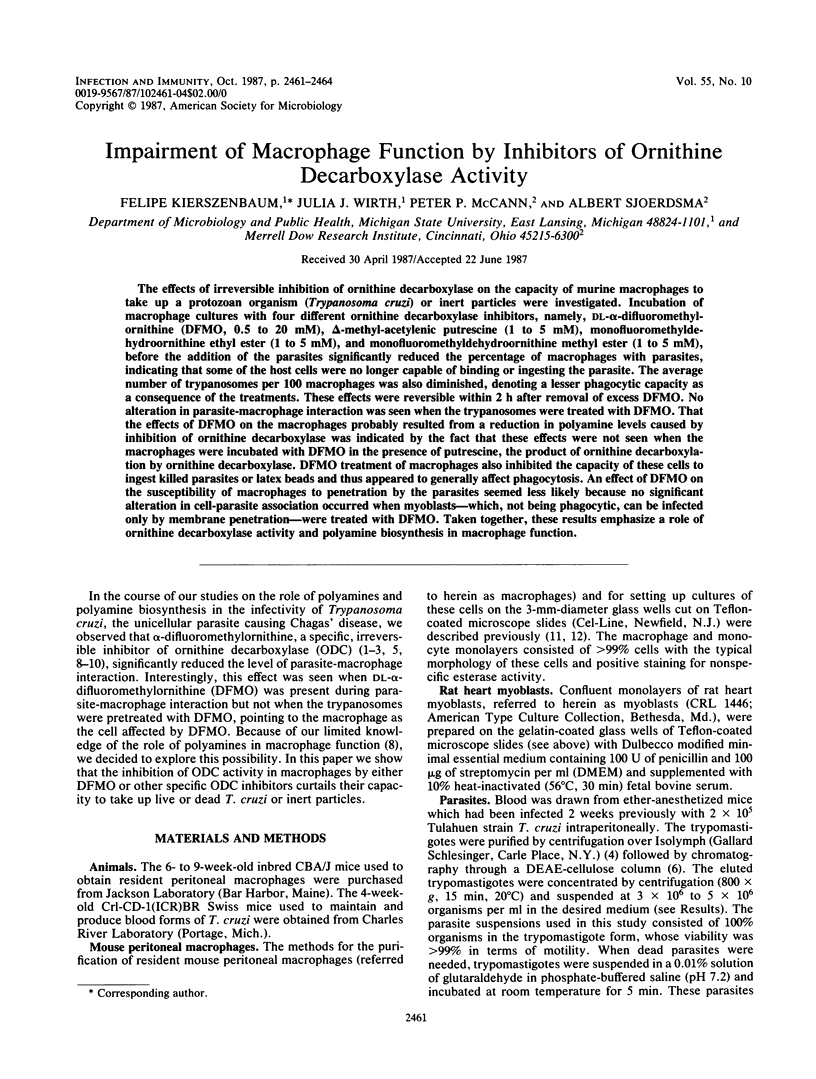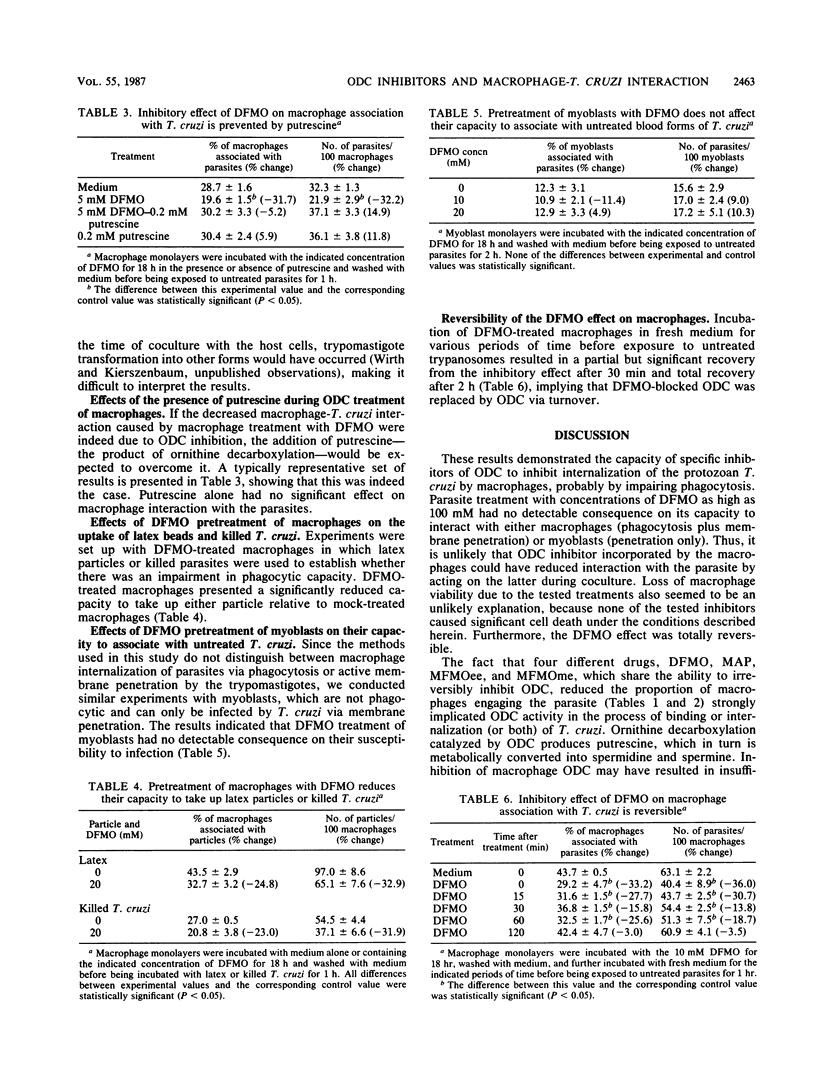Abstract
The effects of irreversible inhibition of ornithine decarboxylase on the capacity of murine macrophages to take up a protozoan organism (Trypanosoma cruzi) or inert particles were investigated. Incubation of macrophage cultures with four different ornithine decarboxylase inhibitors, namely, DL-alpha-difluoromethylornithine (DFMO, 0.5 to 20 mM), delta-methyl-acetylenic putrescine (1 to 5 mM), monofluoromethyldehydroornithine ethyl ester (1 to 5 mM), and monofluoromethyldehydroornithine methyl ester (1 to 5 mM), before the addition of the parasites significantly reduced the percentage of macrophages with parasites, indicating that some of the host cells were no longer capable of binding or ingesting the parasite. The average number of trypanosomes per 100 macrophages was also diminished, denoting a lesser phagocytic capacity as a consequence of the treatments. These effects were reversible within 2 h after removal of excess DFMO. No alteration in parasite-macrophage interaction was seen when the trypanosomes were treated with DFMO. That the effects of DFMO on the macrophages probably resulted from a reduction in polyamine levels caused by inhibition of ornithine decarboxylase was indicated by the fact that these effects were not seen when the macrophages were incubated with DFMO in the presence of putrescine, the product of ornithine decarboxylation by ornithine decarboxylase. DFMO treatment of macrophages also inhibited the capacity of these cells to ingest killed parasites or latex beads and thus appeared to generally affect phagocytosis. An effect of DFMO on the susceptibility of macrophages to penetration by the parasites seemed less likely because no significant alteration in cell-parasite association occurred when myoblasts--which, not being phagocytic, can be infected only by membrane penetration--were treated with DFMO. Taken together, these results emphasize a role of ornithine decarboxylase activity and polyamine biosynthesis in macrophage function.
Full text
PDF



Selected References
These references are in PubMed. This may not be the complete list of references from this article.
- Bacchi C. J., Nathan H. C., Hutner S. H., McCann P. P., Sjoerdsma A. Polyamine metabolism: a potential therapeutic target in trypanosomes. Science. 1980 Oct 17;210(4467):332–334. doi: 10.1126/science.6775372. [DOI] [PubMed] [Google Scholar]
- Bitonti A. J., Bacchi C. J., McCann P. P., Sjoerdsma A. Catalytic irreversible inhibition of Trypanosoma brucei brucei ornithine decarboxylase by substrate and product analogs and their effects on murine trypanosomiasis. Biochem Pharmacol. 1985 May 15;34(10):1773–1777. doi: 10.1016/0006-2952(85)90648-3. [DOI] [PubMed] [Google Scholar]
- Bitonti A. J., McCann P. P., Sjoerdsma A. Necessity of antibody response in the treatment of African trypanosomiasis with alpha-difluoromethylornithine. Biochem Pharmacol. 1986 Jan 15;35(2):331–334. doi: 10.1016/0006-2952(86)90534-4. [DOI] [PubMed] [Google Scholar]
- Budzko D. B., Kierszenbaum F. Isolation of Trypanosoma cruzi from blood. J Parasitol. 1974 Dec;60(6):1037–1038. [PubMed] [Google Scholar]
- Kierszenbaum F., Wirth J. J., McCann P. P., Sjoerdsma A. Arginine decarboxylase inhibitors reduce the capacity of Trypanosoma cruzi to infect and multiply in mammalian host cells. Proc Natl Acad Sci U S A. 1987 Jun;84(12):4278–4282. doi: 10.1073/pnas.84.12.4278. [DOI] [PMC free article] [PubMed] [Google Scholar]
- Mercado T. I., Katusha K. Isolation of Trypanosoma cruzi from the blood of infected mice by column chromatography. Prep Biochem. 1979;9(1):97–106. doi: 10.1080/00327487908061675. [DOI] [PubMed] [Google Scholar]
- Pegg A. E., McCann P. P. Polyamine metabolism and function. Am J Physiol. 1982 Nov;243(5):C212–C221. doi: 10.1152/ajpcell.1982.243.5.C212. [DOI] [PubMed] [Google Scholar]
- Pegg A. E. Recent advances in the biochemistry of polyamines in eukaryotes. Biochem J. 1986 Mar 1;234(2):249–262. doi: 10.1042/bj2340249. [DOI] [PMC free article] [PubMed] [Google Scholar]
- Tabor C. W., Tabor H. Polyamines. Annu Rev Biochem. 1984;53:749–790. doi: 10.1146/annurev.bi.53.070184.003533. [DOI] [PubMed] [Google Scholar]
- Wirth J. J., Kierszenbaum F. Fibronectin enhances macrophage association with invasive forms of Trypanosoma cruzi. J Immunol. 1984 Jul;133(1):460–464. [PubMed] [Google Scholar]
- Wirth J. J., Kierszenbaum F. Inhibitory action of elevated levels of adenosine-3':5' cyclic monophosphate on phagocytosis: effects on macrophage-Trypanosoma cruzi interaction. J Immunol. 1982 Dec;129(6):2759–2762. [PubMed] [Google Scholar]


